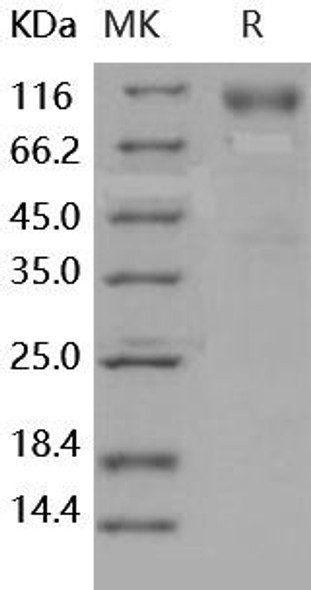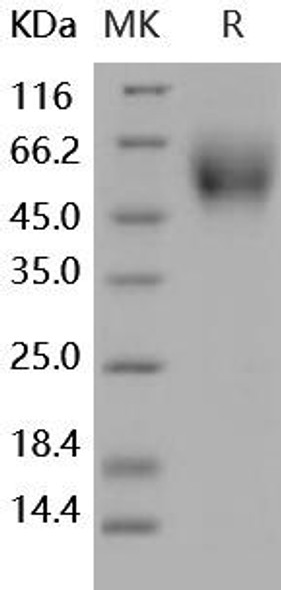Description
| Product Name: | Human TNFRSF21 Recombinant Protein |
| Product Code: | RPPB1041 |
| Size: | 10µg |
| Species: | Human |
| Target: | TNFRSF21 |
| Synonyms: | Tumor necrosis factor receptor superfamily member 21, BM-018, CD358, DR6, Death receptor 6. |
| Source: | Sf9 Insect cells |
| Physical Appearance: | Sterile filtered colorless solution. |
| Formulation: | TNFRSF21 protein solution (1mg/ml) contains phosphate buffered saline (pH7.4),10% glycerol and 0.1 mM PMSF. |
| Stability: | Store at 4°C if entire vial will be used within 2-4 weeks.Store, frozen at -20°C for longer periods of time.For long term storage it is recommended to add a carrier protein (0.1% HSA or BSA).Avoid multiple freeze-thaw cycles. |
| Purity: | Greater than 85.0% as determined by SDS-PAGE. |
| Amino Acid Sequence: | QPEQKASNLI GTYRHVDRAT GQVLTCDKCP AGTYVSEHCT NTSLRVCSSC PVGTFTRHEN GIEKCHDCSQ PCPWPMIEKL PCAALTDREC TCPPGMFQSN ATCAPHTVCP VGWGVRKKGT ETEDVRCKQC ARGTFSDVPS SVMKCKAYTD CLSQNLVVIK PGTKETDNVC GTLPSFSSST SPSPGTAIFP RPEHMETHEV PSSTYVPKGM NSTESNSSAS VRPKVLSSIQ EGTVPDNTSS ARGKEDVNKT LPNLQVVNHQ QGPHHRHILK LLPSMEATGG EKSSTPIKGP KRGHPRQNLH KHFDINEHLE PKSCDKTHTC PPCPAPELLG GPSVFLFPPK PKDTLMISRT PEVTCVVVDV SHEDPEVKFN WYVDGVEVHN AKTKPREEQY NSTYRVVSVL TVLHQDWLNG KEYKCKVSNK ALPAPIEKTI SKAKGQPREP QVYTLPPSRD ELTKNQVSLT CLVKGFYPSD IAVEWESNGQ PENNYKTTPP VLDSDGSFFL YSKLTVDKSR WQQGNVFSCS VMHEALHNHY TQKSLSLSPG KHHHHHH |
Tumor necrosis factor receptor superfamily member 21 or TNFRSF21, is a protein that located in the cell membrane from the TNF receptor superfamily. By activating the NF-kappaB pathway, TNFRSF21 promotes cell apoptosis. The degeneration of cells caused by activating caspase 3 and caspase 6, the TNFRSF21 binds to the N-terminal APP in neuronal cell bodies and axons which leads to apoptosis. TNFRSF21 takes part in signaling cascades activated by stimulation of T-cell receptor.
TNFRSF21 produced in Sf9 Baculovirus cells is a single, glycosylated polypeptide chain containing 547 amino acids (42-349a.a.) and having a molecular mass of 60.4kDa. (Molecular size on SDS-PAGE will appear at approximately 50-70kDa).TNFRSF21 is expressed with a 239 amino acid His tag at C-Terminus and purified by proprietary chromatographic techniques.
| UniProt Protein Function: | DR6: May activate NF-kappa-B and promote apoptosis. May activate JNK and be involved in T-cell differentiation. Required for both normal cell body death and axonal pruning. Trophic-factor deprivation triggers the cleavage of surface APP by beta-secretase to release sAPP-beta which is further cleaved to release an N- terminal fragment of APP (N-APP). N-APP binds TNFRSF21 triggering caspase activation and degeneration of both neuronal cell bodies (via caspase-3) and axons (via caspase-6). Associates with TRADD. Interacts with N-APP. Highly expressed in heart, brain, placenta, pancreas, lymph node, thymus and prostate. Detected at lower levels in lung, skeletal muscle, kidney, testis, uterus, small intestine, colon, spleen, bone marrow and fetal liver. Very low levels were found in adult liver and peripheral blood leukocytes. |
| UniProt Protein Details: | Protein type:Apoptosis; Membrane protein, integral; Receptor, cytokine Chromosomal Location of Human Ortholog: 6p21.1 Cellular Component: axon; integral to plasma membrane; plasma membrane; intrinsic to plasma membrane Molecular Function:protein binding Biological Process: myelination; neuron apoptosis; adaptive immune response; negative regulation of T cell proliferation; negative regulation of myelination; apoptosis; regulation of oligodendrocyte differentiation; B cell apoptosis; negative regulation of B cell proliferation; cellular lipid metabolic process; T cell receptor signaling pathway; humoral immune response |
| NCBI Summary: | This gene encodes a member of the tumor necrosis factor receptor superfamily. The encoded protein activates nuclear factor kappa-B and mitogen-activated protein kinase 8 (also called c-Jun N-terminal kinase 1), and induces cell apoptosis. Through its death domain, the encoded receptor interacts with tumor necrosis factor receptor type 1-associated death domain (TRADD) protein, which is known to mediate signal transduction of tumor necrosis factor receptors. Knockout studies in mice suggest that this gene plays a role in T-helper cell activation, and may be involved in inflammation and immune regulation. [provided by RefSeq, Jul 2013] |
| UniProt Code: | O75509 |
| NCBI GenInfo Identifier: | 21264087 |
| NCBI Gene ID: | 27242 |
| NCBI Accession: | O75509.1 |
| UniProt Related Accession: | O75509 |
| Molecular Weight: | Observed: 72 kDaPredicted: 72 kDa |
| NCBI Full Name: | Tumor necrosis factor receptor superfamily member 21 |
| NCBI Synonym Full Names: | TNF receptor superfamily member 21 |
| NCBI Official Symbol: | TNFRSF21�� |
| NCBI Official Synonym Symbols: | DR6; CD358; BM-018�� |
| NCBI Protein Information: | tumor necrosis factor receptor superfamily member 21 |
| UniProt Protein Name: | Tumor necrosis factor receptor superfamily member 21 |
| UniProt Synonym Protein Names: | Death receptor 6; CD_antigen: CD358 |
| UniProt Gene Name: | TNFRSF21�� |
| UniProt Entry Name: | TNR21_HUMAN |










